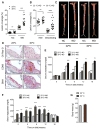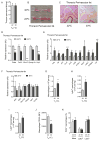Thermoneutral Housing Accelerates Metabolic Inflammation to Potentiate Atherosclerosis but Not Insulin Resistance
- PMID: 26549485
- PMCID: PMC4715491
- DOI: 10.1016/j.cmet.2015.10.003
Thermoneutral Housing Accelerates Metabolic Inflammation to Potentiate Atherosclerosis but Not Insulin Resistance
Erratum in
- Cell Metab. 2016 Feb 9;23(2):386. Tonotonoz, Peter [corrected to Tontonoz, Peter]
Abstract
Chronic, low-grade inflammation triggered by excess intake of dietary lipids has been proposed to contribute to the pathogenesis of metabolic disorders, such as obesity, insulin resistance, type 2 diabetes, and atherosclerosis. Although considerable evidence supports a causal association between inflammation and metabolic diseases, most tests of this link have been performed in cold-stressed mice that are housed below their thermoneutral zone. We report here that thermoneutral housing of mice has a profound effect on the development of metabolic inflammation, insulin resistance, and atherosclerosis. Mice housed at thermoneutrality develop metabolic inflammation in adipose tissue and in the vasculature at an accelerated rate. Unexpectedly, this increased inflammatory response contributes to the progression of atherosclerosis but not insulin resistance. These findings not only suggest that metabolic inflammation can be uncoupled from obesity-associated insulin resistance, but also point to how thermal stress might limit our ability to faithfully model human diseases in mice.
Copyright © 2016 Elsevier Inc. All rights reserved.
Conflict of interest statement
The authors declare that they have no competing financial interests.
Figures







References
-
- Amrein YU. Effects of environmental temperature on Trypanosoma cruzi infection in mice. The Journal of parasitology. 1967;53:1160. - PubMed
-
- Back M, Hansson GK. Anti-inflammatory therapies for atherosclerosis. Nat Rev Cardiol. 2015;12:199–211. - PubMed
-
- Beere PA, Glagov S, Zarins CK. Retarding effect of lowered heart rate on coronary atherosclerosis. Science. 1984;226:180–182. - PubMed
-
- Bensinger SJ, Tontonoz P. Integration of metabolism and inflammation by lipid-activated nuclear receptors. Nature. 2008;454:470–477. - PubMed
Publication types
MeSH terms
Substances
Grants and funding
- DP1AR064158/AR/NIAMS NIH HHS/United States
- R01 DK101064/DK/NIDDK NIH HHS/United States
- HL076746/HL/NHLBI NIH HHS/United States
- DP1 AR064158/AR/NIAMS NIH HHS/United States
- R01 HL066088/HL/NHLBI NIH HHS/United States
- R01 DK094641/DK/NIDDK NIH HHS/United States
- P30 DK026743/DK/NIDDK NIH HHS/United States
- HL066088/HL/NHLBI NIH HHS/United States
- HHMI/Howard Hughes Medical Institute/United States
- P01 HL090553/HL/NHLBI NIH HHS/United States
- R01 HL076746/HL/NHLBI NIH HHS/United States
- P30 DK063491/DK/NIDDK NIH HHS/United States
- P30 CA016042/CA/NCI NIH HHS/United States
- DK094641/DK/NIDDK NIH HHS/United States
- DK101064/DK/NIDDK NIH HHS/United States
LinkOut - more resources
Full Text Sources
Other Literature Sources
Medical
Molecular Biology Databases

